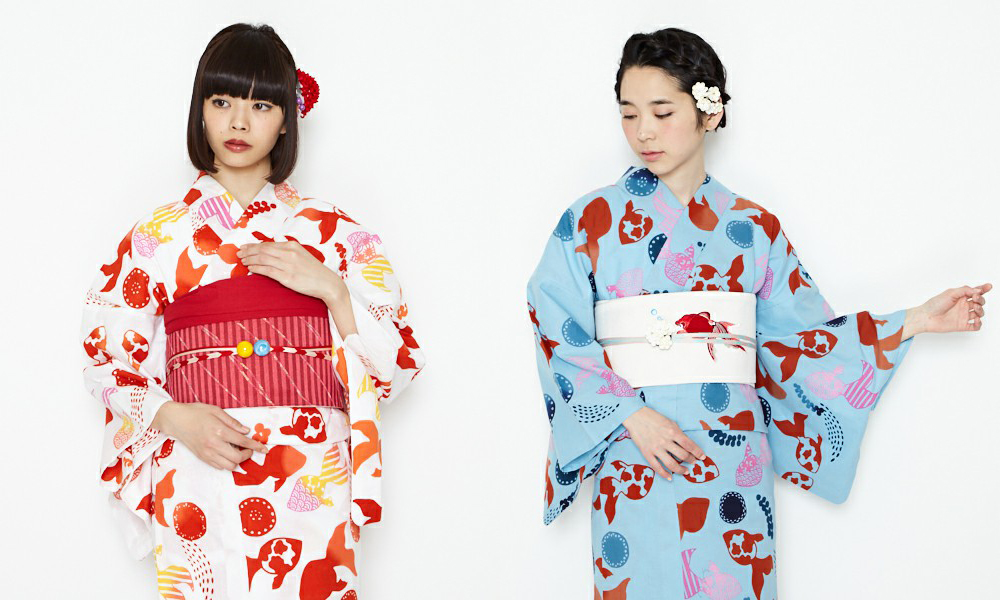Kingyo, Our Newest Summer Collection Print!
This year, to commemorate the summer coming to an end, we are pleased to announce that we have a new addition to our summer-themed print collection. This aquatic blue baby is our nod to one of the most easily recognizable summer symbols in Japan—Kingyo (金魚).
Kingyo is Japanese for goldfish, with the kanji characters 金 (kin) standing for ‘gold’ and 魚 (gyo) for ‘fish’. But there is more to it than meets the eye. The characters are taken directly from Chinese, where 金 (jīn) correspondingly means ‘gold’ and 鱼 (yú) ‘fish’. Here 鱼 (yú) is also a homophone to 余 (yú) of ‘surplus’ or ‘in excess of’, making 金魚 also carry quite an auspicious significance.
Kingyo come in a variety of colours of white, blue, red and shimmering gold. The latter two are most synonymous with goldfish and contribute to the perception of ‘summer colours’ or 夏色 (natsu iro) in Japan. Thus, when it comes to the summer-related products here, kingyo is often chosen as the main adornment on anything from yukata to windchimes, uchiwa, traditional wallets and summer toys, to name a few.
Being a member of the carp family, kingyo is a close relative to koi (鯉), yet easily distinguished by the lack of whiskers or barbels. Over time, kingyo have been bred to obtain different colours and colour combinations, body shapes, and features. Wakin (和金) is one of the most prevailing kingyo kinds today, closely resembling koi in its shape and red-white colouring of scales.
Despite the common misconception, kingyo or goldfish is an intelligent animal with excellent eyesight in perception of 100 million colours (one hundred times more than humans) as well as learning skills that allow them to recall and distinguish between different people, and with active encouragement, even master nifty tricks. With proper care, goldfish are known to live for decades, which makes them a great aquatic long-term companion for us.
Raising a goldfish to its full potential requires a suitable environment that is often mistaken for a fishbowl. In reality, a fish bowl is the worst place one can attempt to keep a goldfish in. Goldfish require lots of space to move around in, in a well-filtered, high oxygen-enriched water habitat. The misconception of using fish bowls as adequate goldfish housing might have originated from China using fishbowls as temporary display vessels. Historically Chinese raised goldfish in ponds, and would only move them briefly into small fish bowls to be admired by their visitors and guests.
Where did this golden creature come from?
Goldfish first became domesticated and selectively bred into the kind that we know and love today around the 10th century in China. Prior to that, goldfish were raised primarily for food purposes. It wasn’t introduced to Japan until 1603 in the Edo era (江戸時代, Edo jidai, between 1603 and 1868). By the end of the Edo era, kingyo was available to everyone and consequently lost its previously appointed status of wealth and sophistication. It was around this time, at the turn of the 19th century, when kingyo became the lead character in the game that would since become the highlight of the summer matsuri (祭, festival) culture in Japan.
Kingyo Sukui
Kingyo Sukui (金魚すくい or 金魚掬い) is a traditional goldfish scooping game that largely became associated with the summer matsuri stalls in the Taisho period (大正時代, Taishou jidai, between 1912 and 1926). Here, the participants would try to fish out kingyo from a large water basin into a bowl with nothing but a rice paper scooper. However, this is easier said than done. The paper scooper breaks easily, and the fish is often too quick to catch, requiring perfect timing for successful scooping. (These days, you can also often find bouncy balls replacing the fish.) If you do succeed, though, you get to take that goldfish home. To this day, the game remains popular equally with adults as with kids.
Our Kingyo print celebrates this long history of kingyo as this splashy symbol of summer in Japan. The colours featured are also known to be the ‘colours of the summer’ or as previously mentioned 夏色 (natsu iro), depicted in kanji characters at the lower left corner of the artwork. Together with the Windchime Watermelon and the Katori Buta Incense prints, it makes for a triple-print Japanese summer print collection that assures the spirit of summer will live in your home all year long.
Click here to shop our PICA Kingyo print. ( ´ ▽ ` )ノ







